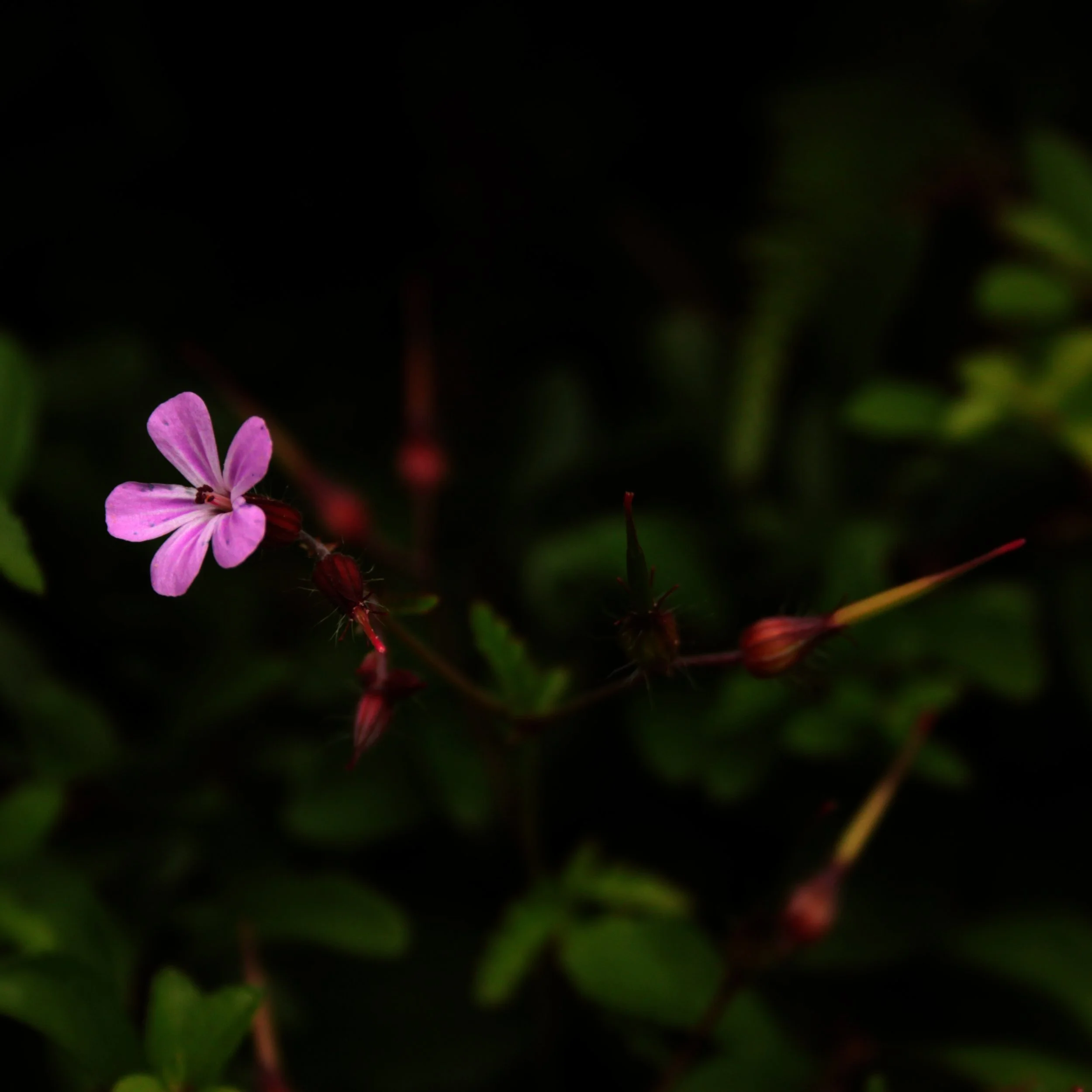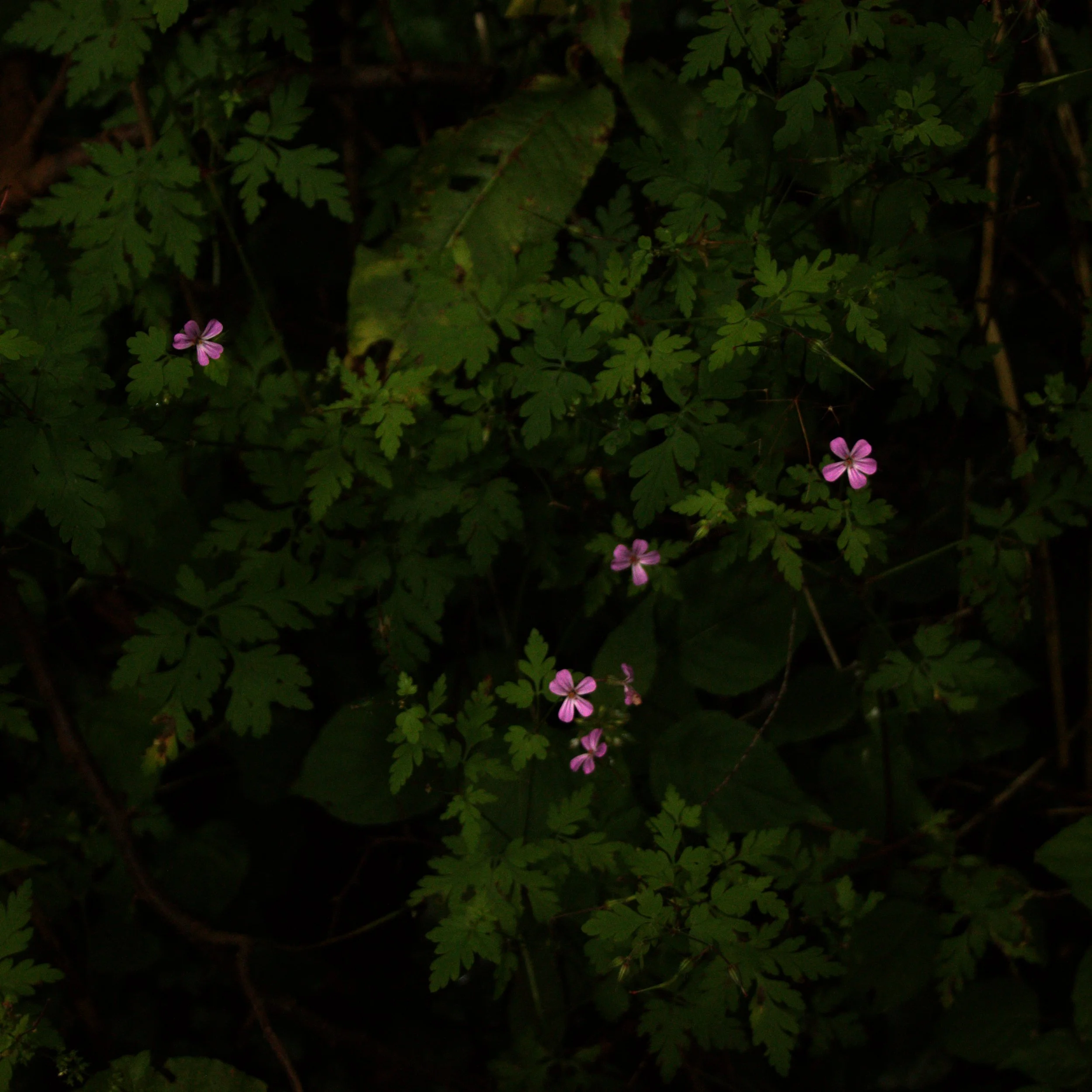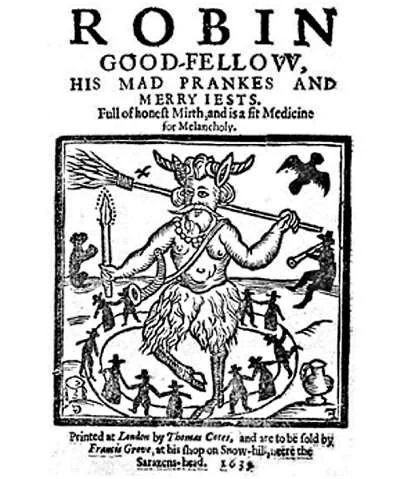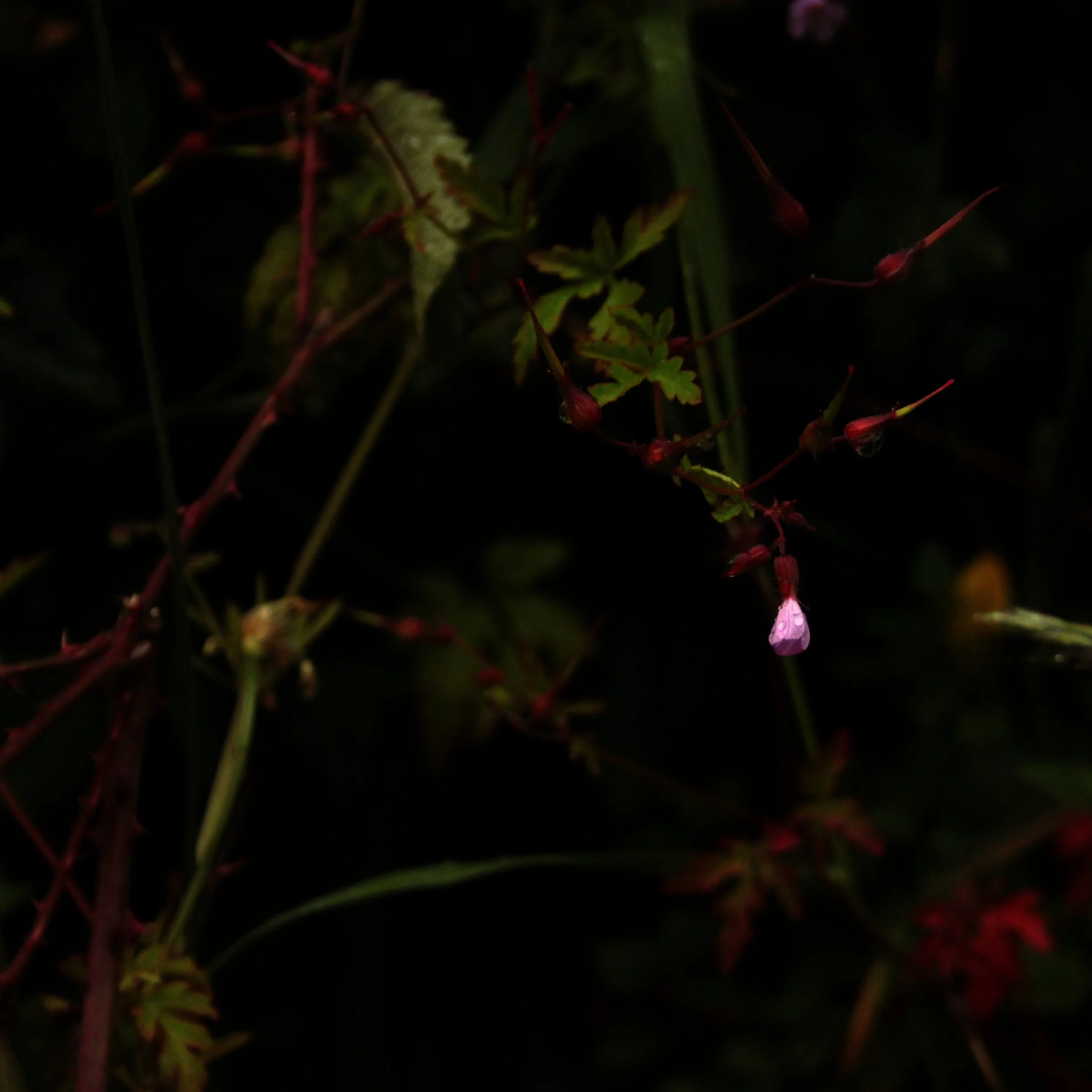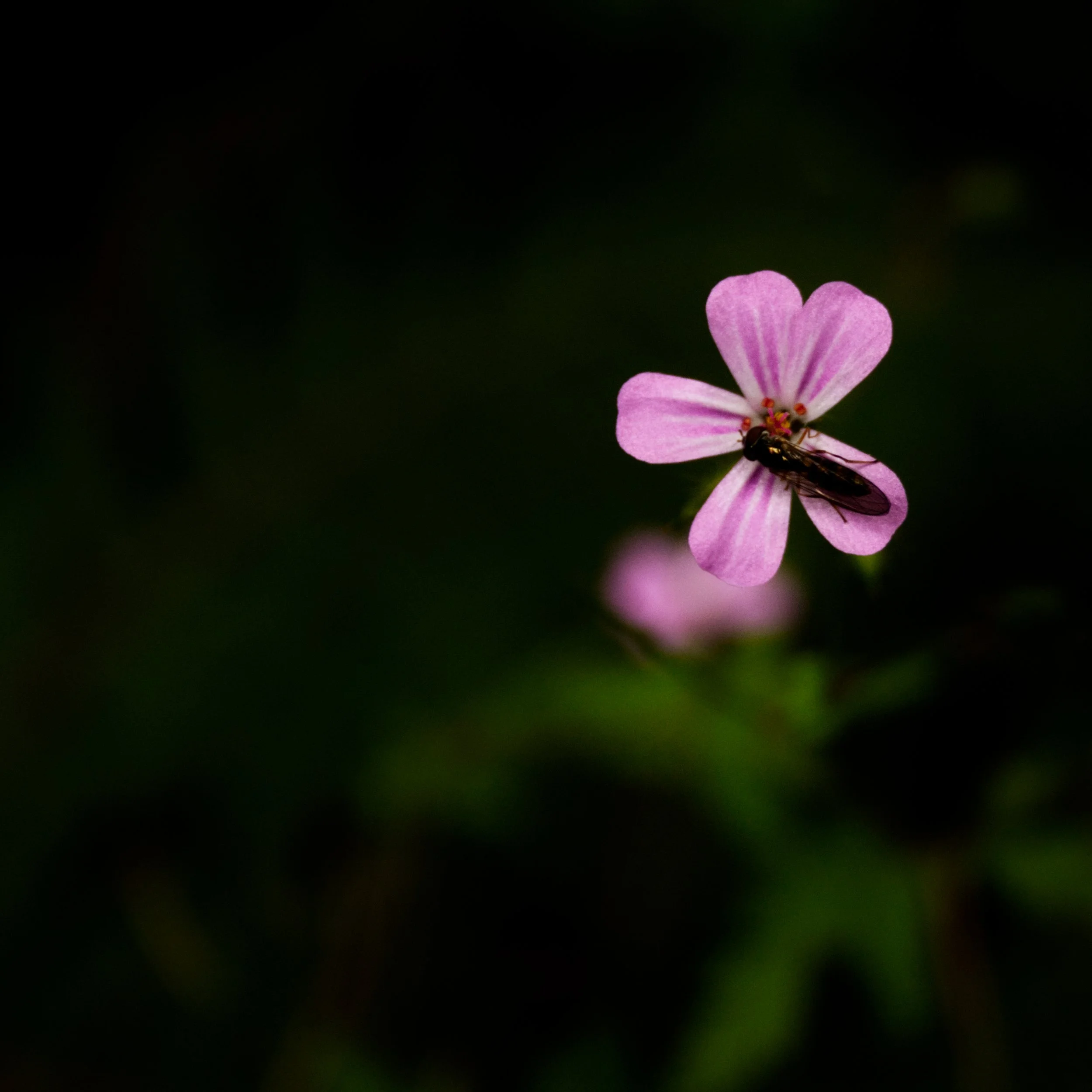July 23 2024
Fox's Herb: Robin Goodfellow and Scottish cancer weed
Welsh common names: Llysiau’r llwynog, Llys y llwynog, Dail Robin
English common name: Herb Robert
Scientific name: Geranium robertianum
A habitual resident of woodlands, verges and the crevices of brick and concrete, Herb Robert is a spindly plant with small pink flowers and fern-like leaves that emerge verdant and green, darkening with time and sun to a deep crimson red. A member of the Geraniums, this family gets its name from the Greek geranos, meaning ‘crane’, inspired by the shape of the seed pod which is bulbous at the base, with a long, thin protrusion resembling the head of a slender-beaked bird; hence the alternative name for geraniums: Cranesbills.
Herb Robert bears a multitude of English common names, some of the most memorable including: Stinking Bob, Biscuit flower, Blood weed, Candlesticks, Victuals, Death come quickly, Knives and forks, Drunkards, Hop o’ my thumb, Jam jars, Sleepy head, Granny thread the needle, Squinter pip and Wren.
Its namesake ‘Robert’ has several origin stories. Possibly a corruption of the latin rubor (meaning red), it’s also suggested the plant was named after 11th century St Robert of Molesme, founder of the Cistercian order, or Robert duke of Normandy.
One of the Welsh names, Dail Robin - meaning ‘Robin’s leaves’ - may refer to Robin Goodfellow; a mischevous Medieval fairy from British folklore (also known as Puck), who haunted both woodland and houses, comprising the body of a man and the hairy legs of a goat. In his hands Robin carries a broom and candlestick; the connection to Herb Robert possibly inspired by the candle-like shape of the seedpods and the hairiness of the stems.
1629 illustration of Robin Goodfellow. Image source: https://www.historic-uk.com/CultureUK/Robin-Goodfellow/
Llysiau’r llwynog has an entirely different meaning however, the English translation being ‘fox’s herb’. This is likely to do with the odour that emanates from the leaves when rubbed, which is supposedly foul like a fox, also evidenced by the English names ‘fox flower’ and ‘fox geranium’, as well as ‘stink flower’, ‘stinker bobs’, ‘stinking Roger’…the list goes on.
This Welsh name also appears as llys y llwynog; while llys is a common word in Welsh place names (meaning court or hall), it’s also an archaic version of llysiau, meaning plant/herb/vegetable. In botany its use simply means plant, similar to the English ‘wort’, that’s rife in wild plant nomenclature.
An ancient medicinal plant, Herb Robert has an extensive list of treatments, such as making eye lotions and a mouthwash for sore throats.
17th century English herbalist Nicholas Culpeper wrote of the ‘government and virtues’ of the plant:
‘It is under the dominion of Venus. Herb Robert is a cure for the stone, and to stay the flow of blood; it is a cure for all green wounds, and is effectual in old ulcers in any part of the body.’
Historically considered a wound herb, it was also believed the plant could mend fractures. Presently, the leaves are still used as a compress for hard to heal wounds, and, when brewed into an infusion, can treat ulcers, diarrhoea and internal bleeding, as well as lowering blood-sugar levels. The leaves also make an effective natural insect repellant when rubbed on the skin.
In Pen Caer, Pembrokeshire, Herb Robert was used to treat cattle suffering from blood in their urine, known as ddwr coch - ‘red water’ - and was mixed with buttermilk and fed to the animals. This remedy is also recorded in County Donegal, and helps to explain the common names Blood weed and Bloody Mary.
Remarkably, in Scotland the plant was historically used to treat cancer, reflected in the Gaelic name lus-an-eallain, meaning ‘cancer weed’. The whole plant was chopped and boiled in water for an hour - a treatment that was still being prescribed by herbalists up to the 1920s - with one claiming multiple successes in Lochend, Invernesshire. This isn’t just folkloric hearsay; a 2023 study in Poland analysed Herb Robert’s anticancer properties, finding that certain extracts (hexane and ethyl acetate) showed potential for treating cancerous cells found in the throat and colon.
Herb Robert is also a food and nectar source for many insects including bees, hoverflies and the barred carpet moth - Martania taeniata - who frequents damp woodlands from June to September, with distinctive mottled brown stripes or ‘bars’ across its pale wings.
Disclaimer: don’t consume or use wild plants for health purposes without speaking to a medical professional first. Be cautious if foraging and only gather plants that you are certain of. These essays are intended to pique interest rather than act as a robust edible or medicinal guide.
Photos by Esther Williams, taken on Lower Quay Road in Hook, Pembrokeshire.
References:
Flowers and Fables: A Welsh Herbal by Jocelyn Lawton
The Complete Herbal by Nicholas Culpeper
Vickery’s Folk Flora by Roy Vickery
Welsh Names of Plants by Dafydd Davies and Arthur Jones
https://www.woodlandtrust.org.uk/trees-woods-and-wildlife/plants/wild-flowers/herb-robert/
https://www.ncbi.nlm.nih.gov/pmc/articles/PMC10223082/

